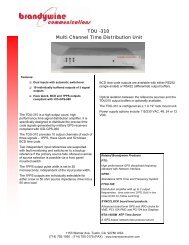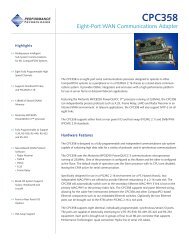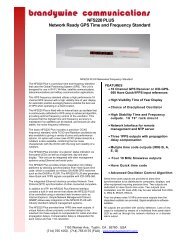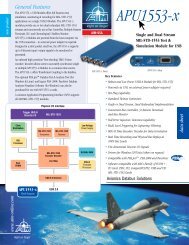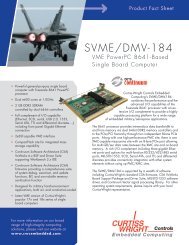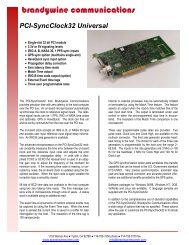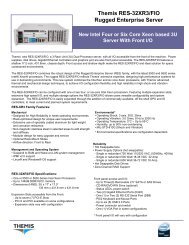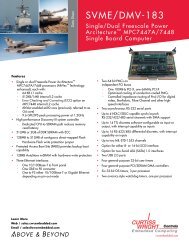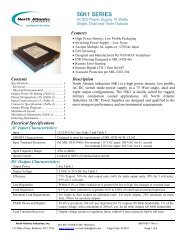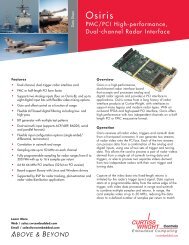PQI StandardII ICF Card 128MB~8GB WideTemp - Unitronix
PQI StandardII ICF Card 128MB~8GB WideTemp - Unitronix
PQI StandardII ICF Card 128MB~8GB WideTemp - Unitronix
Create successful ePaper yourself
Turn your PDF publications into a flip-book with our unique Google optimized e-Paper software.
Datasheet<br />
Signal Name Dir. Pin No. Description<br />
-IOWR<br />
(PC <strong>Card</strong> Memory Mode)<br />
-IOWR<br />
(PC <strong>Card</strong> I/O Mode)<br />
I 35 This signal is not used in this mode.<br />
The I/O Write strobe pulse is used to clock I/O data on the <strong>Card</strong> Data bus<br />
into the CompcatFlash Storage <strong>Card</strong> or CF+ <strong>Card</strong> controller registers<br />
when the CompactFlash Storage <strong>Card</strong> or CF+ <strong>Card</strong> is configured to use<br />
the I/O interface.<br />
The clocking shall occur on the negative to positive edge of the signal<br />
(Trailing edge)<br />
-IOWR<br />
(True IDE Mode – Except<br />
Ultra DMA Protocol)<br />
STOP<br />
(True IDE Mode – Ultra DMA<br />
Protocol Active)<br />
-OE<br />
(PC <strong>Card</strong> Memory Mode)<br />
-OE<br />
(PC <strong>Card</strong> I/O Mode)<br />
-ATA SEL<br />
(True IDE Mode)<br />
In True IDE Mode, While Ultra DMA mode protocol is not active, this signal<br />
has the same function as in PC <strong>Card</strong> I/O mode.<br />
When Ultra DMA mode protocol is supported, this signal must be negated<br />
before entering Ultra DMA mode protocol.<br />
In true IDE Mode, while Ultra DMA mode protocol is active, the assertion of<br />
this signal causes the termination of the Ultra DMA burst.<br />
I 9 This is an Output Enable strobe generated by the host interface. It is used<br />
to read data from the CompactFlash Storage <strong>Card</strong> or CF+ <strong>Card</strong> in Memory<br />
Mode and to read the CIS and configuration registers.<br />
In PC <strong>Card</strong> I/O Mode. This signal is used to read the CIS and configuration<br />
registers.<br />
To enable True IDE Mode this input should be grounded by the host.<br />
READY<br />
(PC <strong>Card</strong> Memory Mode)<br />
O 37 In Memory Mode, this signal is set high when the CompactFlash Storage<br />
<strong>Card</strong> or CF+ <strong>Card</strong> is ready to accept a new data transfer operation and is<br />
held low when the card is busy.<br />
At power up and at Reset, the READY signal is held low (busy) until the<br />
CompactFlash Storage <strong>Card</strong> or CF+ <strong>Card</strong> has completed its power up or<br />
reset function. No access of any type should be made to the<br />
CompactFlash Storage <strong>Card</strong> or CF+ <strong>Card</strong> during this time.<br />
Note, however, that when a card is powered up and used with RESET<br />
continuously disconnected or asserted, the Reset function of the RESET<br />
pin is disabled, Consequently, the continuous assertion of RESET from the<br />
application of power shall not cause the READY signal to remain<br />
continuously in the busy sate.<br />
-IREQ<br />
(PC <strong>Card</strong> I/O Mode)<br />
INTRQ<br />
(True IDE Mode)<br />
I/O Operation - After the CompactFlash Storage <strong>Card</strong> or CF+ <strong>Card</strong> has<br />
been configured for I/O operation, this signal is used as interrupt Request.<br />
This line is strobe low to generate a pulse mode interrupt or held low for a<br />
level mode interrupt.<br />
In True IDE Mode signal is the active high interrupt Request to the host.<br />
Rev. A.5 11/45 Mar. 2009



